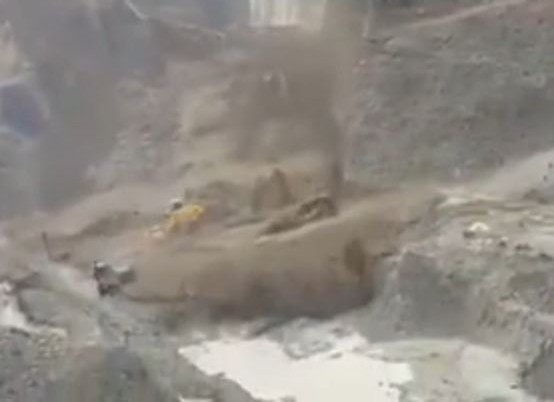3 June 2015
Pharkant, Burma: a liquefaction landslide in mine tailings (with a stunning video)
Posted by Dave Petley
Pharkant, Burma: a liquefaction landslide in mine tailings
Pharkant is an important jade mining area in Burma. The mining is causing environmental destruction on an epic scale, and has been associated with large landslides on a number of previous occasions in recent years. The landslides appear to be primarily the result of poor mining practices, and in particular of inadequate management of the spoil generated by the mining activity.
Landslides in mine wastes are a major problem. In the UK the issue is best known because of the 1966 Aberfan landslide, in which the collapse of a spoil buried a school, with disastrous consequences. More recently, in 2013 a huge mine waste landslide in Tibet caused extensive loss of life. There are many, many other examples. One of the reasons for the terrible impact of these slides is the phenomenon known as liquefaction, in which apparently solid earth materials can transform into a very weak, fluid mass that can move both rapidly and over long distances. Under certain conditions some types of mine waste can undergo liquefaction, and very often it is the failure to manage (i.e. prevent) this process that causes catastrophic mine-related landslides.
Two videos have appeared on Youtube this week with no fanfare that illustrate this process to a degree that is unprecedented in my opinion. The videos apparently show a liquefaction landslide that occurred at Pharkant on 9th April 2015. The footage appears to have been shot from a mobile phone, and so it is understandably shaky. But I don’t think a mining-induced liquefaction landslide has ever been caught on camera like this. In terms of quality of the footage, the better video is the one that shows the second half of the landslide sequence:
.
.
The video starts as the first wave of debris spreads across the floor of the mine. Note the retrogressive nature of the landslide thereafter – material on the slope behind is going through progressive liquefaction and flowing down slope. The video is in effect capturing liquefaction in real-time.
Even better is the fact that the initial collapse event was also captured on video. Unfortunately, but understandably, the quality is much less good. In particular the video is rotated (is there a way of correcting this, does anyone know). But the footage captures the initial surge reaching the floor of the mine and sweeping up the machinery. The power and violence of the flow is terrifying:
.
.
The machines being swept up in the flow are not small by any means:

Pharkant liquefaction landslide via Youtube


 Dave Petley is the Vice-Chancellor of the University of Hull in the United Kingdom. His blog provides commentary and analysis of landslide events occurring worldwide, including the landslides themselves, latest research, and conferences and meetings.
Dave Petley is the Vice-Chancellor of the University of Hull in the United Kingdom. His blog provides commentary and analysis of landslide events occurring worldwide, including the landslides themselves, latest research, and conferences and meetings.
Hi Dave,
NASA’s Earth Observatory has a page on Nepali landslides posted today.
http://earthobservatory.nasa.gov/IOTD/view.php?id=85977&eocn=home&eoci=iotd_readmore
Is that mine tailings or conglomerate that is being stripped or mined for the boulders containing jade? See http://www.palagems.com/burma_jade.htm, Fig 11 which geologically looks similar.
Figure 11. At Nansibon, backhoes are used to work the serpentinite boulder conglomerate in which jadeite boulders occur in narrow horizontal concentrations. Photo © George E. Harlow.